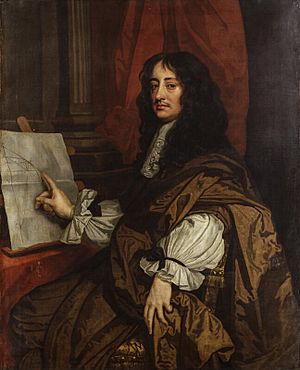William Brouncker, 2nd Viscount Brouncker facts for kids
Quick facts for kids
The Viscount Brouncker
|
|
|---|---|
 |
|
| President of the Royal Society | |
| In office 1662–1677 |
|
| Preceded by | Office established |
| Succeeded by | Joseph Williamson |
| Personal details | |
| Born | c. 1620 Castlelyons, Ireland |
| Died | 5 April 1684 (aged 64) Westminster, London |
| Residence | England |
| Alma mater | University of Oxford |
| Known for | Brouncker's formula, leadership of Royal Society |
| Scientific career | |
| Fields | Mathematician, civil servant |
| Institutions | Saint Catherine's Hospital |
| Academic advisors | John Wallis |
William Brouncker, 2nd Viscount Brouncker (born around 1620 – died April 5, 1684) was an important Anglo-Irish nobleman and a brilliant mathematician. He was the very first president of the Royal Society, a famous group of scientists, from 1662 to 1677.
Brouncker is most famous for creating something called Brouncker's formula. He also worked for the government as a civil servant, helping to manage the Royal Navy. He was a friend and colleague of Samuel Pepys, whose famous diary often mentions Brouncker.
Contents
About William Brouncker
William Brouncker was born around 1620 in Castlelyons, County Cork, Ireland. His father, also named William Brouncker, was the 1st Viscount Brouncker. His family originally came from England. His grandfather had moved the family to Ireland many years before.
William earned a special medical degree from the University of Oxford in 1647. For a while, he stayed out of public life because he supported the King. During this time, he focused on his studies in mathematics.
His Work and Public Life
William Brouncker was one of the people who helped start the Royal Society. This was a new and important group for scientists. He became its very first president in 1662.
In the same year, he became a special helper to Queen Catherine. He also became one of the main managers for the Royal Navy in 1664. His work there is often mentioned in the famous Diary of Samuel Pepys. Even though they sometimes disagreed, Samuel Pepys usually thought highly of Brouncker.
Later, in 1677, Brouncker was no longer president of the Royal Society. He was not happy about this, even though he hadn't been attending meetings very often. From 1679, he helped manage the office of the Lord High Admiral of England.
William Brouncker never married. When he passed away in 1684, his title went to his brother, Henry.
His Mathematical Discoveries
William Brouncker's math work focused on figuring out the lengths of curved lines, like those in a parabola or a cycloid. He also worked on finding the area under a hyperbola curve. This involved using a method to get closer and closer to the right answer, called an infinite series.
He was the first person in Europe to solve a math problem now known as Pell's equation. He was also the first in England to become interested in a type of fraction called generalized continued fractions. Building on the work of another mathematician, John Wallis, Brouncker found a way to express the number pi using a special continued fraction.
Brouncker's Formula
Brouncker's formula is a way to write the number pi (π) using a special kind of fraction that goes on forever:
This formula can also be written like this:
Even though it's a clever way to show pi, Brouncker's formula isn't used much today for calculating pi. This is because it takes a very long time to get a precise answer using this method.
Images for kids
See also




